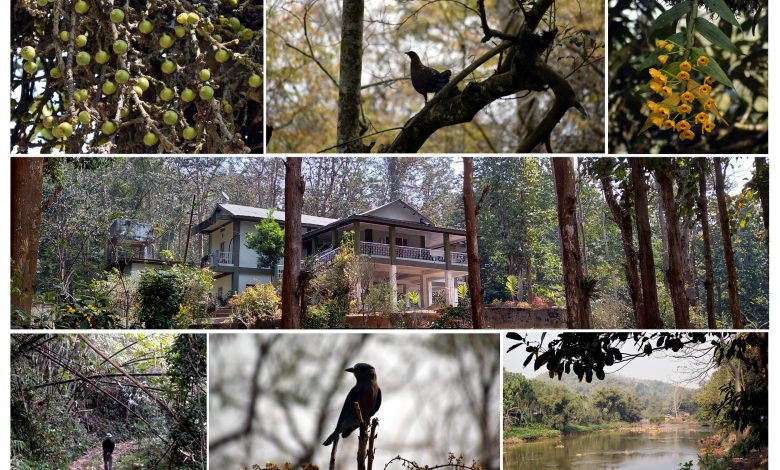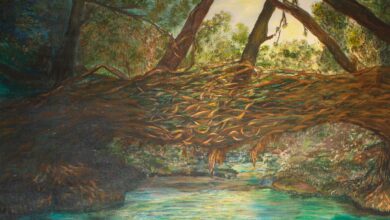Discover a whole new world
With its wide variety of floral and faunal species, Nongkhyllem Wildlife Sanctuary in Ri Bhoi is the best protected reserve area in the North East, writes MICHAEL SHYLLA

The ongoing pandemic has restricted our movements and upended our travelling plans. But the crisis is short-lived and will end one day. If you are already preparing the list of places to visit post pandemic, then Meghalaya should find a prominent place in it not only because of the scenic hills and mischievous clouds but also for the rich bio-diversity in the state.
The Nongkhyllem Wildlife Sanctuary is one place in Meghalaya that a visitor should not miss. The reserve forest is near Lailad village in Ri Bhoi, approximately 30 minutes’ drive from the Byrnihat toll gate. Covering an area of 29 sq m, the forest has a variety of plants, animals, fungi and micro-organisms.
A quaint government bungalow sits on a hillock surrounded by tall teak trees and the River Umtru, locally called Wah Lailad, flows nearby.
The Nongkhyllem Wildlife Sanctuary is among the best biosphere reserves in the country where one gets to sight majestic species like the Indian large red-billed hornbill, the Makhna elephants, bison, sambar deer, clouded leopard, amur falcon, water monitor lizard, emerald dove, Burmese roller and capped langurs, to name a few.
The flora and fauna species found here have attracted the attention of wildlife enthusiasts and researchers from all over the country. In 1982, the floral variety in Nongpoh and its vicinity noted about 1,036 classes or orders of vegetation belonging to 639 genres of 159 families spread over 200 sq km.
Studies show that a unit of the Western Ghats forests, another bio-diversity hot spot, harbours fewer species as compared to these forests. There are over 400 species of birds, including some endangered species like the rufous-necked hornbill. This particular bird is locally extinct in Nepal due to hunting and significant loss of habitat.
The reserve forest harbours over 50 species of mammals and 25 species of reptiles. Out of 140 species of mammals listed in Schedule-1 of the Wildlife (Protection) Act, 1972, about 30 species are found in the Nongkhyllem Wildlife Sanctuary.
I visited the reserve when life was not fettered by protocols and fear of a deadly virus. During my visit, I had met a few forest staff who told me about a large turtle that was found in the forest and was brought to the bungalow. It was sick and a veterinary doctor was called from Guwahati for treatment. The turtle was 3 ft in length 2 ft in height and weighed about 25kg. During the course of treatment, the turtle was kept in the bungalow for observation. It may be mentioned, sick turtles require intensive care, including fluid therapy and force-feeding. Abscess, if any, is treated surgically, the wound is opened and flushed with a medicated solution. During the course of treatment, the turtle became active, gained appetite and started moving on the premises.
The forest staff, who rescued the animal, later relocated the turtle to the same spot in the forest. Turtles have small home territories and should be left where they are found. Some turtles are dangerous too. For example, one has to take special care when dealing with a snapping turtle. These turtles may be as much as 19 inches long and weigh up to 35 pounds. They have powerful jaws and a long neck. Snapping turtles can kill alligators with their powerful jaws. Hence the name snapping alligator turtle.
Poaching menace
The Nongkhyllem Wildlife Sanctuary is one of the most natural habitats of wildlife in the North East where poaching of animals, fishing and trapping of birds are strictly prohibited. On April 19, the forest department conducted raids and confiscated many items meant for smuggling. The Tokay Geckos were packed in bamboo pieces in an inhuman condition. A pangolin was found severely injured and even after providing the best possible care and treatment by the veterinary doctor of the department, the animal could not be saved. Both the animals are on the endangered list.
These creatures are valued at a very high price in the international market. Few years back, the state police of Manipur conducted a manhunt to arrest the top ring leaders of a gang of poachers involved in smuggling Tokay Gecko, a rare reptile species, from Manipur to Malaysia. Some members of the gang were arrested. These reptiles are in high demand in Malaysia and some other Asian countries because of their medicinal value. Sources said a smuggler can make up to Rs 20 lakh for a Tokay Gecko weighing 200 gm and measuring 14 inches.
In another incident on April 20 this year, a consignment of elephant tusks (weighing 3.3kg) through the Patharkhmah-Umling road was intercepted by forest officials of Meghalaya and the culprits were arrested. The sanctuary not only conserves the biodiversity but also the culture of the place.
The endangered species in the reserve require more care and the forest officials regularly provide blocs (salts) as mineral lick. The salts are important nutrients for wild animals as they provide essential elements such as phosphorus and the biometals (sodium, calcium, iron, zinc and trace elements) required for the growth of bone, muscle, blood circulation and other health benefits. Such licks are especially important in ecosystems with poor general availability of nutrients.
A walk inside the forest
As we started walking into the sanctuary, we could feel that the forest was so alive with the melodious sound of birds — whistling, chirping, hooting and shrieking. I wondered who was whistling so melodiously, without a care in the world, that too in the wilderness. As we walked deep inside the forest, we reached a spot to hear a lovely melodious song-like whistle coming from a distance. I was taken aback and I looked to the right. A bird was looking for something, I could not believe my ears as the sound was so human-like. I pulled out my camera from the bag and zoomed at the bird, took the shot and again it whistled. Now, I knew who was whistling that lovely tune all this while and it was no other than the Burmese roller (Caracias affinis). It flew away instantly.
The sanctuary has thick vegetation of different varieties and bamboos, which were aplenty all over the upper and lower slopes. As you may be aware that bamboos grow in the wild just like any other plant species though they prefer areas which have flowing streams. Animals thriving on them would habit places close to vast areas of bamboos. That is why Makhna elephants and other animals of the sanctuary are frequently found in these spots eating bamboo leaves.
Tall bamboo trees are pulled down by elephants to the ground so that they can eat the tender nutritious leaves. Other animals also take advantage and join the treat. The most important thing in the bamboo leaves is dietary fibre and selica, which is a type of food substance that has many health benefits like increasing the growth of bones, nails and good hair health.
Another nutrient that is no less important is fibre eating and this is very good for digestive health. Gooseberries and wild figs which grow in the sanctuary, are another attraction for animals and even invite birds from a great distance. Both fruits are nutritious and have many health benefits for their growth.
The Nongkhyllem Wildlife Sanctuary has been found to be the best-protected area in the North East, according to management effectiveness (MME) reports of national parks and wildlife sanctuaries. The report ranked Meghalaya at 79.17% (very good) on January 19 year.
Making it better
Inside a wildlife sanctuary is a whole new world that lies miles away from the civilisation and the technology of the time. The experience at Nongkhyllem is similar. There were no television, mobile connectivity and internet. All one has is natural abundance around.
However, technology has become an intrinsic part of our lives and we often find ourselves grappling in the dark without facilities like the internet or mobile connectivity.
BSNL is doing good work in providing signals in rural areas. The bungalow is not far from Lailad. In this case, the forest department can request BSNL to provide services at least on the premises of the bungalow so that the authorities can still maintain a small business centre for their guests to do their work. JIO signals are widely available in the Kanha National Park, the Khatia and Mukki gates to enable consistent internet facility. No doubt the IB is beautiful and well-maintained but more rooms can be extended, including dormitories for men and women, to cater to students who come to stay for a longer period for research.
Also, the path inside the forest needs to be improved which will not cost much for the development. Small safari jeeps can be arranged for visitors to travel inside the forest.
The sanctuary already possesses all the natural resources required for its habitat. It will be appreciable if more flora and fauna species, which can thrive in this climatic condition, can be brought from outside the state to attract more visitors. Brochures can also be printed about the Nongkhyllem Wildlife Sanctuary and put these in the bungalow for guests. This is another way of advertising when they carry these brochures back home.
Last but not the least, television is no doubt a very powerful visual media for providing effective coverage and publicity for the Nongkhyllem Wildlife Sanctuary and its forest reserve.
(The author is retired director, Ministry of Information & Broadcasting)
Photographs by author
Have you ever experienced the exotic beauty of a wildlife sanctuary? Please share your story on
meghalaya.monitor@gmail.com




